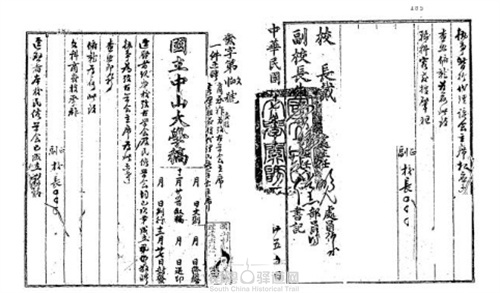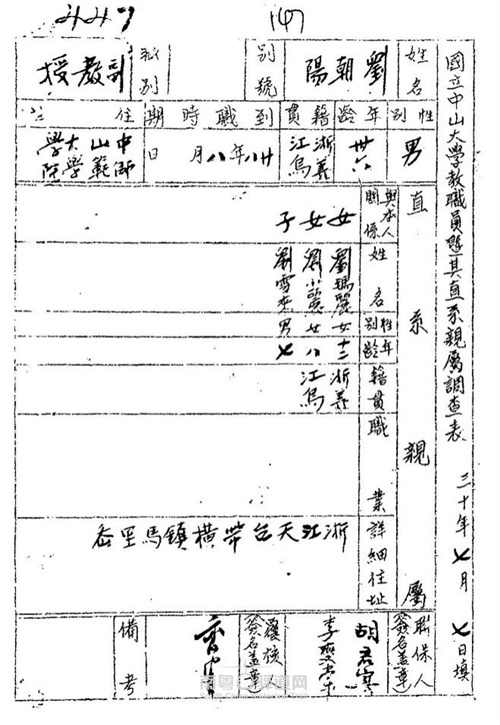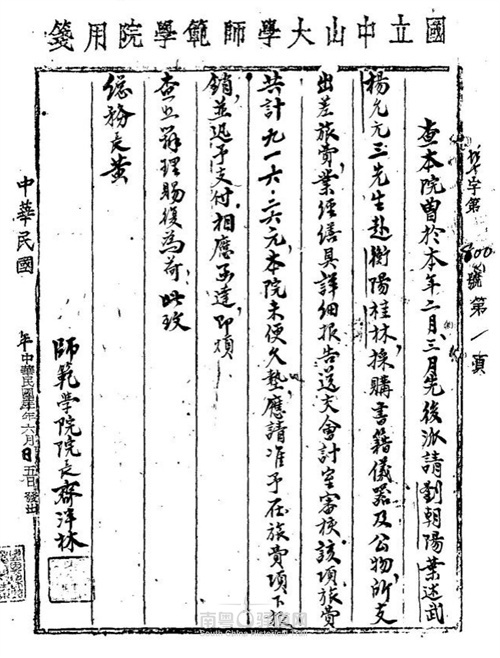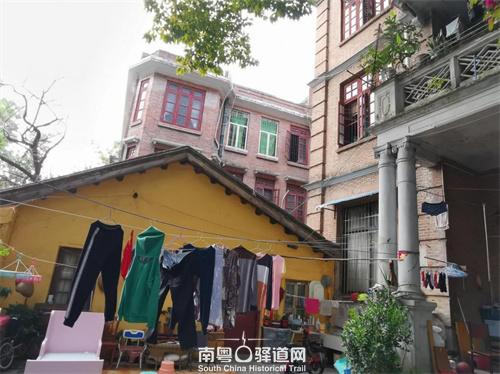Section 2: Historical research on Southern languages is still ongoing
The main leaders in folklore were basically young teachers of Philology and History at National Sun Yat-sen University, and the preparations for the founding of the Institute of History and Philology of the Academia Sinica relied on the talents of the "Institute of Philology and History", and in the founding essay of Fu Si-nian also made "folklore" of folklore In his founding essay, Fu Si-nian also made folklore "folk art" one of the research directions. However, most folklore scholars remained in Guangzhou and did not choose to go north.
On 6 September 1928, Institute of History and Philology sent a letter to Liu Hannong proposing a plan for a group of folklore literature and arts Je budget to be submitted, and in the following days Liu Hannong drew up the Plan and Budget for the Folklore Group. 20 September 1928 Liu Hannong was appointed as a part-time researcher, and resigned from his part-time position on 20 August of the same year. Folk literature and art developed poorly in the early years of Institute of History and Philology, and the team in folklore studies at Sun Yat-sen University continued to act as an important academic force.
In 1927, the Folklore Society of Sun Yat-sen University was established, and the Folklore Weekly, Folklore Literature and Art, was launched. Gu Jie-gang, He Sijing, Chen Xixiang, Yang Chengzhi and Zhong Jingwen were active initiators and contributors, exploring the concept and classification of folklore, providing a new platform for scholars in the study of regional culture, and a precursor to the future development of anthropology. The first issue of Folklore Weekly published a translation of Yang Chengzhi's "Questions of Folklore" in eleven consecutive issues. When Yang Chengzhi was investigating the ethnic groups in Yunnan, he compiled and published some of the contents in Folk Weekly in time, such as 'Children's Songs of Qiaojia County, Yunnan', which was published in Folk Weekly (Issue 44) in 1929, and letters sent along the way to Gu Siegang, Fu Sian and Rong Zhaozu, which were also published in Folk Weekly. The Folk Weekly was published until June 1933, and the Folk Quarterly was published in 1936 until after the fall of the school in Ping Shi in 1944.
In 1929, when the university asked the societies to reorganize into academic groups, He Sijing became the head of the Folklore Group of the Institute of Philology and History of Sun Yat-sen University. In 1929, when the university asked the societies to reorganise themselves into groups, He Sijing became the head of the Folklore Section of the Institute of Language and History at Sun Yat-sen University, and Shang Chengjo, who had been the president of the Archaeological Society, became the head of the Archaeological Section.

The picture shows a letter of appointment from the principal of National Sun Yat-sen University, dated 27 December 1927, appointing Shang Cheng-jo, a professor of matriculation, as President of the Archaeological Society, in the Guangdong Provincial Archives.
Huang Zhongqin (1884-1942), a professor at Ling University and Zhonghua University, a famous writer of inscriptions and posters, in 1928 Fu Sian and three other preparatory members wrote to Cai Yuanpei, Yang Xingfo recently hands-on event, the first of nine research work is "Quanzhou investigation", Huang Zhongqin is responsible for this project. 2 September Fu Sian to Cai Yuanpei, on Huang Zhongwen's Recommendation note "32 years old, Huang Zhongqin, professor of matriculation at Sun Yat-sen University, now investigating Quanzhou, formerly studying in Japan." Gu Guegang leaves Guangzhou and Huang sends to Hong Kong, "February 24, today's senders: Shao Meng, Meng Zhen, Ze Xuan, Liv, Lin Chao, Da Ding, Shu Xiu and his wife, Mrs Xin Tian, Kun Yi, Jing San, Guan Ying, Yanong." Among the senders was Yanong, who at this time was still in Guangzhou and had not yet gone to Beijing. "On February 25, in order to buy tickets, Zhongqin's father, sons, nephews and Chen Jun came more than once, and by 4 p.m. they were able to set up a cruise ...... for this northbound trip, thanks to the greetings of Zhongqin's family, and were able to take the cruise ." He died in Hong Kong during the war and was buried in Hong Kong. He was one of the professors who contributed the most, whether he was looking for a house for the Institute of History and Language and colleagues from the north, or taking the Institute of History on a mission to investigate and research, write reports, take charge of the archives sent to the Civil Affairs Department of Guangdong Province to categorize and organize as the director of the archives group, and introduce the "Methodology for Organizing the Archives of the Civil Affairs Department of the University", etc., quietly and unobtrusively.
After graduating from Xiamen University, Liu Chaoyang worked as a teaching assistant in the Department of Liberal Arts and Education in Guangzhou, and later participated in the study of Yin and Shang and ancient astronomy, working with Dong Zubin to systematize the fragmentary lunar and solar stems and branches from divination dictionaries and to summarize the calendar of the Yin and Shang periods.In March 1928, Liu Chaoyang completed his work on "The Original Geometry", which was preceded by "Western History in the Second Half of the Nineteenth Century" in issue 6 of The Week, "The Evidence of Archaeology" in issue 18 of The Week, and "Numbers before the Qin" in issue 19 of The Week. Evidence" was translated in Issue 18 of the Weekly, and "Numbers before Qin" was published in Issue 19 of the Weekly. In the section 'Origin', Liu Chaoyang completed his article 'A Study of shi Ji Tian Guan Shu in the Records of the Grand Historian', which was written for a special issue on astronomy in the Natural Sciences edited by the Science Department, under the guidance of Fu Sian and Gu Jegang, and was dated 1 March at the Institute of Philology and History. The long paper was published in a special issue of the combined issues 73-74 of the Weekly, published on 27 March 1929. The paper became a classic in the study of ancient astronomy. The professors of arts were very instrumental in nurturing their successors. Yu Yongliang revised the final draft of The Age of the Divination of the Yi Gua and its Author, completing the first draft in November 1927, with the note "After the completion of this paper I was obliged by Brother Gu Gu Jie to read and revise it for me." From 1937 to 1942, Liu Chaoyang returned to the Department of Science and Chemistry at the Teachers' College of Sun Yat-sen University as an associate professor and professor, leaving Sun Yat-sen University in the second half of 1942.

The picture shows the registration form for Liu Chaoyang's appointment as an associate professor at the Normal College of Zhongshan University in 1939, in the Guangdong Provincial Archives.

The picture shows Liu Chaoyang, who was still teaching at the Teachers' Training College during the Guanbu period, and a report of his trip to Hengyang with Ye Shuwu, who needed funds to purchase instruments, in the Guangdong Provincial Archives.
In February 1929, the university increased the funding for the Institute of Philology and History, which did not have the funds to hire professors and recruit postgraduates, and only started to do so that year. When the Institute of Philology and History moved to Beiping, Mr Gu left Guangzhou, and the first article in the Weekly, No. 80, dated 8 May 1929, was a preface to Mr Gu's "Chronology", in which he emphasised the need to engage in the compilation of chronologies, calendars, maps, directories and statistical tables as tools for the study of history, and was dated 17 April 1929. The preface was written after Mr Gu's departure from Guangzhou on 17 April 1929, to a book by Mr Shi Xiangya of Soochow University, and reflects Gu's affection for the Institute of Philology and History. Mr. Luo Changpei wrote the first sentence of the volume in Dongshan on 30 January 1929; Mr. Dong Zubin's "Chronology of Yang Xiong, a dialectologist" was written on 4 March 1928; Mr. Chen Blunt published "Europeanizing the dialect of Guangzhou" and "Writings on dialects in old books"; the three professors had already moved from teaching in Guangzhou to teaching history in Beiping. On 9 October 1929, he published "The Hundredth Anniversary Issue", which was written by Professors Wen Yu, Jiang Jingsan, Wei Juxian, Huang Zhongqin, Yung Zhaozu and Shang Chengjo. Jiang Jingsan was a librarian at Sun Yat-sen University and an assistant at the Institute of Philology and History when he first arrived in Guangzhou. He translated such famous works as Modern Idealism and The Study of Realism from 1926 to 1928, and was appointed professor at the School of Education of Guangdong Province's Carlton University in 1934. The last few issues of the Weekly were written by young scholars, with Xia Tingzuo, assistant professor in the Department of History, and Wei Yinglin, assistant member of the Institute, gradually taking up the responsibility. Wei Yinglin, a native of Minhou, Fujian, graduated from Xiamen University and was appointed as an assistant to the Institute in August 1928. Wei Yinglin established himself as a Chinese historian with his History of Chinese Studies, published in 1941.
Scholarly research in the south continued with the publication of a special issue on writing in the combined issues 125-138 of the Weekly on 23 April 1930 and Yang Chengzhi's Report on the Ethnic Survey of Yunnan in the combined issues 129-132 of the Weekly on 21 May 1930.
Section 3: Colleagues in the Department of Biology, Faculty of Science
It can be said that the survey of the Yao (Yao) people of Guangxi and northern Guangdong by the School of Biology of the National Sun Yat-sen University, although not included in the Institute of History and Philology, made up for the lack of anthropological surveys in the earlier period for the Institute of History and Philology. The Collected Journals published in Beiping (second book, fourth division) published Pang Xinmin's 'Miscellaneous Notes on the Yao Mountains of Beijiang, Guangdong', by the Department of Biology, College of Science, National Sun Yat-sen University. In the 1932 issue of the Collected Journals (Book IV, Division 1), the report of the survey conducted by Jiang Zhefu, Pang Xinmin and a collection team from the Biology Department of Sun Yat-sen University, which entered the Yao Mountains for the fourth time in 1930, was published in Guangzhou on 2 October 1930.
Yang recalls his first encounter with information on the Yao tribe in northern Guangdong in 1928, when he published his book Visits of the Yao People by Chen Xixiang. When he was teaching at Ping Shi in northern Guangdong, Yang Chengzhi's second systematic exposure to research changed the term 'Yao' (猺)to 'Yao'(傜), i.e. Yao(傜) people, Yao(傜) language, etc.
When they were at the Faculty of Arts at Sun Yat-sen University, Fu Sinian and Gu Jie-gang were extremely supportive of the biology department's collection teams going into the Yao Mountains in northern Guangdong to collect plant and animal specimens while conducting folklore expeditions to obtain the results of their bi-disciplinary investigations.
Mr. Xin Shubi in the "Academic Newsletter" section, and Fu Sian by way of correspondence to discuss ethnic survey issues, including 11 July 1928 in the "Weekly" No. 37 Xin Shubi letter notes as follows: "Meng Zhen my brother Hui Jian: I asked Ren Jun to send a reply? I have also asked you to draw a map for me to read. On the 9th (the day after Ren's return to Guangzhou.) I went with Huang Jizhuang (an assistant professor in the Department of Botany, who had come to Guangxi with my brother last year to collect plants and plants, and who has made a special effort to study the mulberry family and amniotic plants; he is also a very promising young man). He went to Jinxiu (the main village of Zaisan Yao.) I went to Jinxiu (the main village of Zhaishan Yao) to investigate, and it took me four days to get there and back, trekking through mountains and streams. [38] In August 15 of the same year, Xin Shu Banner invited Gu Jie Gang to see the results of the three months' collection of specimens and folklore songs in Yao Shan, which would be moved to the display room of folklore objects. In 1934 Xin Shuqi sent Shi Shenghan, Wu Yinchan and Ren Guorong to England, Germany and France to study.
Mr. Xin Shubi was the head of the Department of Biology at the time, and on 29 August 1928, Fu Sinian sent a letter to Mr. Cai Yuanpei on the proposed list of appointments, employing Xin Shubi as a special researcher. in 1933, Mr. Xin became the director of the National Compilation Library, making significant contributions to the standardization of Chinese scientific nomenclature. in 1938, he became the director of the Northwest Agricultural College, and later in 1946, he founded Lanzhou University. Shi Shenghan became a famous Chinese plant physiologist and historian of agronomy when his teacher went to the northwest and subsequently taught there. Wu Yin Chan returned to China and served as the director of the Institute of Botany at Sun Yat-sen University, the school's deputy provost, a famous Chinese botanist; Ren Guorong teacher, Guangdong High School teacher turned into the first batch of graduate biology students at Guangdong University, then went to the National Museum in Paris to study birds, later became a famous Chinese bird experts, moved with the school to Ping Shi in northern Guangdong to continue teaching, was the dean of the College of Science at Sun Yat-sen University in 1945 to 1946.
Xin Shu-zhi, Shi Shenghan, Ren Guorong, Huang Jizhuang, Wu Yinchan and Cai Guoliang of the Department of Biology, Faculty of Science, took the first important step towards the investigation of ethnic folklore and anthropological surveys and research in the Institute of History and Philology.

Baiyuan Compound Taken on February 28, 2022
Finished on April 2, 2022
Notes.
[1]South China Historical Trail Project Group, Returning to the Historical Time and Space of Yang Lüan Martyr in Guangzhou, Guangzhou: Zhongshan University Press, 106 pp.
[2] Guangdong Provincial Archives Collection, File No. 020-003-73-085--090.
[3] Wu Bian: "Memories of Meng Zhen", in Lamentations and Elegies of the late President Fu, vol. 2.
[4] Gu Jie Gang, "Diary of Gu Jie Gang," vol. 2, Beijing: China Book Bureau, 2011, 147 pp.
[5] Wang Fan-sen, Pan Guangzhe, and Wu Zhengshang: "The Posthumous Notes of Fu Sian", Beijing: Social Science Literature Press, 2011, 83 pp.
[6] Guangdong Provincial Archives Collection, File No. 020-003-73-085--090.
[7] Shang Chengjo: The Collected Writings of Shang Chengjo, Guangzhou: Zhongshan University Press, 2004, 19 p.
[8] Gu Jie-gang, The Collected Letters of Gu Jie-gang, vol. 2, 348 pp.
[9] Yu Dafu, Nine Kinds of Diaries, Zhengzhou: Zhongzhou Guji Publishing House, 2019, 2 pp.
[10] Editorial Unit of the General Affairs Section of the Guangzhou Municipal Government: Repertory of Guangzhou Municipal Reports, 1928, p. 5.
[11] Guangzhou Municipal Government, edited by: Guangzhou Municipal Government Statistical Yearbook, 1929, p. 445.
[12] Guangzhou Municipal Government, edited by the Guangzhou Municipal Government: Statistical Yearbook of the Guangzhou Municipal Government, 1929, p. 453.
[13] Sun Yat-sen: The Founding of the State, 1921.
[14] Guangzhou Municipal Government: Statistical Yearbook of Guangzhou Municipal Government, 1928, p. 3.
[15] "Two Plans in the Climax of Municipal Innovation Movement", Guangzhou Municipal Bulletin 1930.
[16] [U.S.] John M. Levy, Modern Urban Planning, China People's University Press, 2003, p. 46.
[17] Nan Yue Ancient Post Road Project Group: Returning to the historical time and space of Yang Lüan Martyr in Guangzhou, Guangzhou: Zhongshan University Press, 106 p.
[18] Nan Yue Ancient Post Road Project Group: Returning to the Historical Space and Time of Yang Lagenda's Martyrs in Guangzhou, Guangzhou: Zhongshan University Press, 165 p.
[19] National Sun Yat-sen University, Language History: The Complete Weekly Collection of the Institute of Language History, National Sun Yat-sen University, Beijing: National Printing House Press, 2011, 541 pp.
[20] Gu Jie-gang's Notes on Reading, vol. 2, Beijing: Zhonghua Book Bureau, 2011, 345 pp.
[21] Ouyang Zhe-sheng, Fu S-nian's Collected Works, vol. 7, Beijing: Zhonghua Book Bureau, 2017, 86 pp.
[22] Wang Fan-sen, Pan Guangzhe, and Wu Zhengshang: The Posthumous Notes of Fu Sian, Beijing: Social Science Literature Press, 2011, 102 pp.
[23] Institute of Chinese Studies, Tsinghua University: Li Ji Wen Cun, Nanjing: Jiangsu People's Publishing House, 2018, 81 pp.
[24] Dai Jun: Biography of Li Ji, Beijing: The Commercial Press, 2021, 101 pp.
[25] Biographical Literature (Taiwan), 1976, vol. 28, no. 1.
[26] National Sun Yat-sen University, Language History: The Complete Weekly Collection of the Institute of Language History, National Sun Yat-sen University, No. 2, Beijing: National Printing House Press, 2011, 207 p.
[27] Wang Fan-sen, Pan Guangzhe, and Wu Zhengshang: "Fu Sian's Posthumous Notes," Beijing: Social Science Literature Press, 2011, 84 to 91 pages.
[28] National Sun Yat-sen University, Language History: The Complete Weekly Collection of the Institute of Language History, National Sun Yat-sen University, Beijing: National Printing House Press, 2011, 114 p.
[29] Yang Chengzhi: The Collected Works of Yang Chengzhi, Guangzhou: Zhongshan University Press, 2004, 232 pp.
[30] Yang Chengzhi, Yang Chengzhi's Anthropological Ethnographic Anthology, Beijing: Nationalities Press, 2003, 132 pp.
[31] Zhao Xinna and Huang Peiyun, The Chronology of Zhao Yuanren, Beijing: Commercial Press, 1998, 160 pp.
[32] Wang Fan-sen, Pan Guangzhe, and Wu Zhengshang: The Posthumous Notes of Fu Sian, Beijing: Social Science Literature Publishing House, 2011, 94 pp.
[33] National Sun Yat-sen University, Institute of Language History, National Sun Yat-sen University: The Complete Weekly Collection of the Institute of Language History, National Sun Yat-sen University, 6 volumes, Beijing: National Printing House Press, 2011, 187 p.
[34] Wang Fan-sen, Pan Guangzhe, and Wu Zhengshang: "Fu Sian's Last Journal," Beijing: Social Science Literature Press, 2011, 129 pp.
[35] Gu Jie-gang's Diary, vol. 2, Beijing: China Book Bureau, 2011, 22 pp.
[36] Gu Jie-gang, Gu Jie-gang's Diary, vol. 2, Beijing: Zhonghua Book Bureau, 2011, 147 pp.
[37] Gu Jie-gang, Gu Jie-gang's Letters, vol. 2, Beijing: Zhonghua Shuji, 2011, 183 pp.
[38] National Sun Yat-sen University, Language History: The Complete Weekly Collection of the Institute of Language History, National Sun Yat-sen University, No. 2, Beijing: National Printing House Press, 2011, 35 pp.
(All rights reserved. Please indicate that it is from South China Historical Trail Network.)
责任编辑:彭剑波